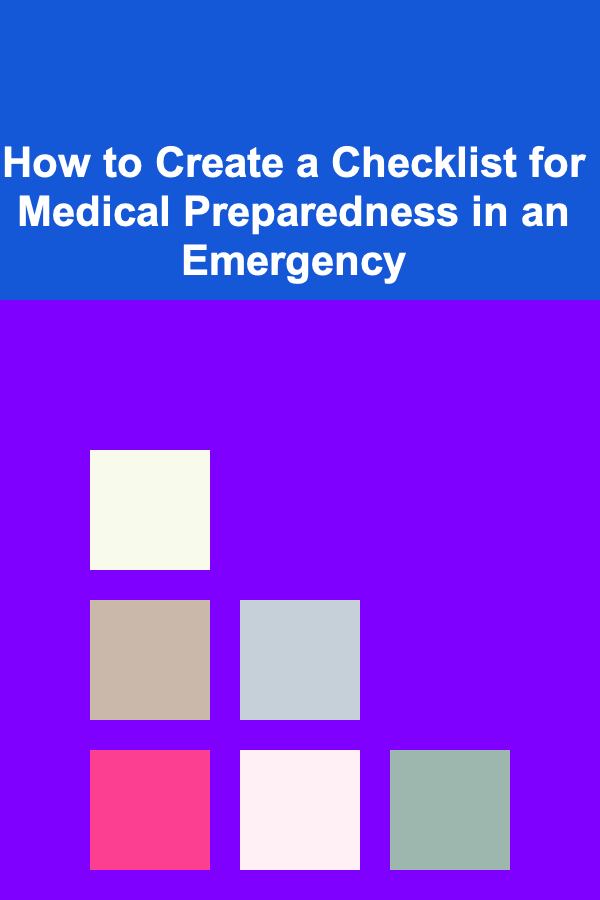
How to Build a Checklist for Defining Job Roles and Responsibilities
ebook include PDF & Audio bundle (Micro Guide)
$12.99$11.99
Limited Time Offer! Order within the next:

Defining job roles and responsibilities is one of the most critical aspects of organizational structure. Clear roles ensure that employees understand what's expected of them, contribute effectively to team objectives, and work within the scope of their capabilities. This clarity also helps managers with performance evaluations, resource allocation, and strategic planning. But creating a solid checklist to define job roles and responsibilities can be a challenging task. It requires a careful balance between clarity and flexibility, and an understanding of the broader business goals.
This guide will walk you through the essential steps to build an actionable checklist for defining job roles and responsibilities, ensuring that your team is aligned and equipped to meet the demands of the workplace.
Step 1: Understand the Organizational Needs
Before diving into individual roles, it's essential to assess the overall needs of the organization. Each job role should align with the company's mission, goals, and values. A clear understanding of these needs will help you create roles that contribute to the broader objectives.
Actionable Tips:
- Review Organizational Goals: Understand the long-term strategic objectives and how various roles can help achieve them. For instance, if your company is focused on expansion, roles should emphasize growth, client acquisition, and scalability.
- Identify Skill Gaps: Analyze existing roles to spot any skills or competencies that are lacking. This will help you define new roles or adjust current ones to fill those gaps effectively.
- Consider Team Dynamics: Understanding how different roles interact within the team is crucial. Roles should complement one another and ensure smooth collaboration and communication.
By aligning job roles with the organization's objectives, you lay a strong foundation for defining responsibilities that drive results.
Step 2: Define the Core Functions of Each Role
Each job role should have a clear and defined set of core functions. These functions are the primary tasks that the person holding the role is expected to perform regularly. Without this clarity, employees may become confused about their duties, leading to inefficiencies or role overlap.
Actionable Tips:
- List Key Responsibilities: Start by outlining the day-to-day duties that the role requires. This includes both routine tasks and essential deliverables.
- Prioritize Responsibilities: Not all duties are equally important. Rank tasks based on their importance to organizational goals. This helps employees focus on what truly matters.
- Use Action-Oriented Language: Avoid vague descriptions. Use clear, action-oriented verbs such as "manage," "develop," "create," or "coordinate" to describe what the role entails.
By focusing on these core functions, you ensure that job descriptions are detailed, actionable, and focused on tangible outcomes.
Step 3: Establish Required Skills and Qualifications
The next step in creating a checklist for defining job roles is identifying the skills and qualifications necessary for each position. These can include technical skills, soft skills, and educational qualifications that are essential for performing the tasks defined in the core functions.
Actionable Tips:
- Technical Skills: Identify the specific tools, platforms, or technologies required for the job. For example, a software developer would need expertise in specific programming languages or frameworks.
- Soft Skills: Soft skills like communication, problem-solving, and collaboration are often just as important as technical skills. Be specific about the level of proficiency required for these skills.
- Experience and Education: Define the minimum level of education, certifications, or work experience necessary for candidates. This ensures that candidates are adequately prepared for the role.
Clarifying the skills and qualifications ensures that you hire the right people and sets expectations for current employees seeking to advance in the organization.
Step 4: Determine Reporting and Accountability Structure
Understanding who reports to whom, and how performance is assessed, is crucial for both employees and managers. Each role should be clear on who they report to and how their performance is evaluated within the larger organizational framework.
Actionable Tips:
- Reporting Relationships: Define who the employee will report to, and clarify whether they will manage any other individuals or teams. This helps create a clear chain of command.
- Key Performance Indicators (KPIs): Establish measurable metrics that will be used to assess job performance. For example, if the role involves sales, KPIs might include monthly sales targets or client retention rates.
- Feedback Mechanisms: Make sure there are clear processes for giving and receiving feedback. Whether through regular one-on-ones, quarterly reviews, or other channels, feedback helps employees understand their strengths and areas for improvement.
A well-defined reporting and accountability structure ensures that everyone is clear on their responsibilities and performance expectations, reducing confusion and fostering a productive environment.
Step 5: Outline the Role's Scope and Limits
While it's important to define the responsibilities of each job, it's equally essential to establish the boundaries of the role. Without clear limits, employees may end up taking on tasks outside their job description, which can lead to burnout, role confusion, or inefficiency.
Actionable Tips:
- Define Boundaries: Clearly outline what is included in the job description and, just as importantly, what is not. This helps manage employee expectations and prevents role creep.
- Limit Scope Based on Seniority: Consider the seniority of the role. Senior positions might have more strategic decision-making responsibilities, while entry-level positions will focus on operational tasks.
- Provide Flexibility: While boundaries are important, leave some flexibility for the role to evolve over time. Businesses are dynamic, and job roles may need to adjust as the company grows or shifts focus.
By clearly defining the scope, you prevent ambiguity and ensure that everyone knows their responsibilities, minimizing overlap with other roles.
Step 6: Incorporate Collaboration and Cross-Departmental Work
Modern organizations require a high level of collaboration. Therefore, it's important to define how each role fits into the larger team dynamic. Understanding interdepartmental collaboration can prevent silos and improve workflow.
Actionable Tips:
- Identify Key Collaborators: Each role should identify who they need to collaborate with. This includes other teams, departments, or individuals within the company.
- Clarify Collaborative Tasks: Define any tasks that require collaboration, such as cross-functional projects or team meetings. This ensures that the role doesn't operate in isolation.
- Communication Expectations: Set expectations for communication, both within the team and across departments. This includes preferred communication channels (email, Slack, meetings, etc.) and response times.
Encouraging collaboration helps ensure that teams work together toward common goals, which increases overall productivity and morale.
Step 7: Review and Refine Job Descriptions Regularly
Once you've defined job roles and responsibilities, it's crucial to revisit them periodically. As business goals shift, so too should the roles within the organization. Regularly reviewing job descriptions ensures that they remain relevant and aligned with the company's objectives.
Actionable Tips:
- Conduct Annual Reviews: At least once a year, revisit each role to ensure it still meets the company's needs. Consider the changes in technology, market conditions, or organizational structure that may impact the job description.
- Solicit Employee Feedback: Get input from employees in each role. They are often the best source of information about what works and what doesn't within their job description.
- Adapt to Company Growth: As your company evolves, the complexity of roles may increase. Make sure to adjust job responsibilities to match the scale and scope of the organization's growth.
By keeping job descriptions up to date, you ensure that roles stay relevant and support the continued success of the organization.
Conclusion
Building a checklist for defining job roles and responsibilities is not just about creating a job description---it's about ensuring that each employee understands their function within the broader organizational framework. By following the steps outlined in this guide, you can create clear, actionable roles that contribute to the efficiency, morale, and success of your team.
From understanding organizational needs to regularly reviewing job descriptions, these steps provide a holistic approach to defining roles that not only serve the organization's immediate goals but also allow for flexibility and growth in the future.

How to Create a Checklist for Holiday Lighting Setup: An Actionable Guide
Read More
How to Create a Checklist for Medical Preparedness in an Emergency
Read More
How to Use Surveys to Gather Tenant Satisfaction Feedback
Read More
Smart Tips for Renting Equipment Instead of Buying: Save Space and Cash
Read More
The Best Budget-Friendly Alternatives for Personal Care Products That Actually Work
Read More
How To Choose the Best Protection for Extreme Sports
Read MoreOther Products

How to Create a Checklist for Holiday Lighting Setup: An Actionable Guide
Read More
How to Create a Checklist for Medical Preparedness in an Emergency
Read More
How to Use Surveys to Gather Tenant Satisfaction Feedback
Read More
Smart Tips for Renting Equipment Instead of Buying: Save Space and Cash
Read More
The Best Budget-Friendly Alternatives for Personal Care Products That Actually Work
Read More